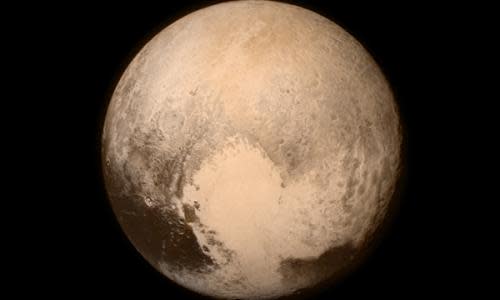Australian stargazers invited to join hunt for mysterious Planet 9

Everyday stargazers will have a shot at naming a new planet by joining Australian astronomers in the hunt for a mysterious large orb believed to be circling the fringe of the solar system.
Australian National University researchers have invited the public to join them in the hunt for so called “Planet 9” by combing through a massive array of new pictures mapping the southern sky.
They hope that eagle-eyed amateurs will help discover Planet 9, which is predicted to be four times as big as Earth with 10 times its mass, but has never been seen.
In return, the planet’s finder has been promised input into the name put forward by the ANU team to the International Astronomical Union, which would make the final call.
ANU astrophysicist Brad Tucker said modern computers were no match for the passion of millions of people that would make possible the discovery of Planet 9 “and other things that move in space”.
But Tucker, who is leading the project, hinted that a break from planet naming tradition using ancient mythology would be in order.
“I don’t want another Greek god, we have enough of those,” he told Guardian Australia. “I’d want to think of something else.”
Tucker hopes the lure of getting to name other objects in the sky that will inevitably be discovered during the search will pique public interest.
“If you need a last minute birthday gift, or something like that, why not find an asteroid and name it after your wife?” he quipped.
The ANU from Monday will launch online access to the first complete digital map of the southern sky. It is made up of hundreds of thousands of pictures taken by a robotic telescope called the SkyMapper at the university’s Siding Spring Observatory.
Members of the public will be invited to scan time-lapse images for signs of new objects, in what Tucker likened to playing “where’s Wally?” on a grand scale.
Similar searches of the vast majority of the northern sky have failed to turn up Planet 9.
Chris Wolf, a co-researcher on the Planet 9 search and head of SkyMapper, said the 1.3m telescope was the only one in the world that mapped the whole southern sky.
“Whatever is hiding there that you can’t see from the north, we will find it,” he said.
Tucker said Planet 9 was predicted to exist – and likely to show up in the southern hemisphere – because it would explain why Pluto, discovered in 1930, was a dwarf planet and had a “weird orbit”.
“This is exactly how both Neptune and Pluto were discovered - mathematically it made the orbits of other planets make sense, and then they were found a bit later,” he said.
“Planet 9 is predicted to be a super Earth, about 10 times the mass and up to four times the size of our planet. It’s going to be cold and far away, and about 800 times the distance between Earth and the sun. It’s pretty mysterious.”
The search for Planet 9 would also lead to the discovery of new asteroids, comets and dwarf planets like Pluto, which also opened up potential naming rights for the public, Tucker said.
Tucker said rules set by the International Astronomical Union meant finders could not name asteroids or dwarf planets after themselves “but you could name it after your wife, brother or sister”.
The astronomy team decided not to create movies of GIFs of the night sky for the public to assess but to “add the images together” so that a potential object moving over three points in time would stand out in colour.
“In theory you should see a black sky with a bunch of white stars, but then there are these three coloured objects – a red dot, a blue dot and a green dot - that stand out in a line,”
“So it really is ‘where’s Wally’, finding where is the colour difference among everything.
“People can then click on those dots that will auto-generate and calculate its orbit trajectory, which will tell us to go look at it through another telescope to go, is it really there, and what is it?”
“We’re going to find thousands of new asteroids and probably a few dwarf planets, too.”

 Yahoo News
Yahoo News 